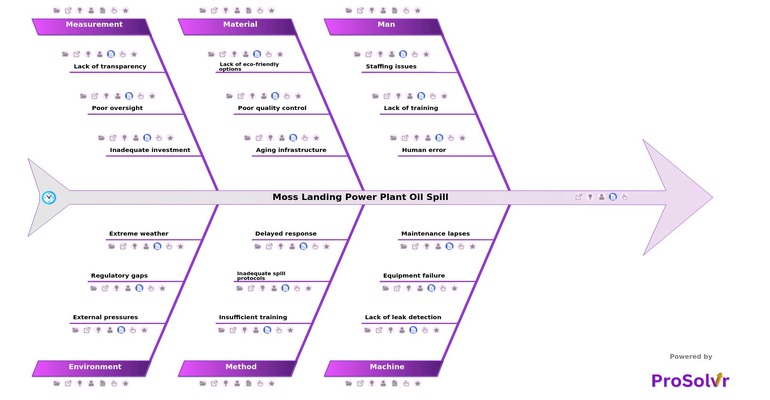Root Cause Analysis of Moss Landing Power Plant Oil Spill
The Moss Landing Power Plant, situated in California, USA, encountered a catastrophic oil spill in October 2021, causing extensive environmental damage and posing significant risks to marine ecosystems and coastal communities. This report aims to provide an in-depth analysis of the incident, exploring the underlying factors that contributed to this environmental disaster.
The analysis delved into various aspects of the spill incident, examining factors related to personnel, equipment, procedures, materials, management, and external influences. By scrutinizing each aspect, the report aims to uncover the root causes of the oil spill and recommend measures to prevent similar incidents in the future.
Inadequate training and awareness among plant personnel regarding spill prevention and response emerged as significant contributors to the incident. Human error and staffing issues further exacerbated the situation, highlighting the need for robust training programs and competent staffing to enhance operational safety.
Equipment failures, maintenance lapses, and the absence of effective leak detection systems were identified as key factors in the spill. These shortcomings underscore the importance of rigorous maintenance practices, equipment upgrades, and the adoption of advanced technologies to prevent oil spills.
Gaps in spill response protocols, delayed actions, and insufficient training were evident in the plant's procedures. This emphasizes the necessity for well-defined response protocols, continuous training, and simulation exercises to improve preparedness and response effectiveness during emergencies.
Challenges related to poor quality control, aging infrastructure, and the lack of environmentally sustainable alternatives for oil storage and handling were observed. Addressing these issues requires investment in high-quality materials, infrastructure upgrades, and the adoption of eco-friendly solutions to ensure operational reliability and environmental protection.
Inadequate oversight, insufficient investment in safety measures, and a lack of transparency within the management structure were also identified. Proactive management approaches, routine monitoring, and transparent communication are essential for enhancing accountability and fostering a culture of continuous improvement.
The Moss Landing Power Plant oil spill underscores the critical importance of proactive measures and continuous improvement in industrial operations. By addressing the root causes identified in this analysis and implementing the recommended measures, the plant can enhance safety, protect the environment, and mitigate the risks of similar incidents in the future. This fishbone analysis serves as a roadmap for the plant to strengthen its operational resilience, safeguard its reputation, and contribute to a more sustainable future for the community and the environment.
Who should use the Moss Landing Power Plant Oil Spill template?
This template for a detailed Root Cause Analysis (RCA) report on the Moss Landing Power Plant oil spill is designed for various stakeholders involved in the incident and its aftermath. Here's a list of potential users who could benefit from using this template:
- Plant Management and Operations Teams: Plant managers, operational leaders, and safety officers can use this template to understand the root causes of the oil spill and implement corrective actions to prevent similar incidents in the future.
- Environmental Agencies and Regulatory Bodies: Environmental agencies, regulatory bodies, and government officials can utilize this template to assess the incident's environmental impact and recommend regulatory changes or enforcement actions.
- Risk Management Teams: Risk management professionals and insurance companies can leverage this template to evaluate the incident's risk profile, assess liabilities, and develop risk mitigation strategies.
- Safety Consultants and Auditors: Safety consultants, auditors, and third-party evaluators can use this template to conduct independent assessments, validate findings, and provide expert recommendations to improve safety protocols and procedures.
- Community and Public Stakeholders: Community leaders, local residents, and other public stakeholders can utilize this template to gain insights into the incident, understand its implications for public health and safety, and advocate for improved safety and environmental protections.
- Legal Teams and Attorneys: Legal teams, attorneys, and legal advisors can use this template to gather evidence, assess liabilities, and prepare legal strategies for potential litigation related to the oil spill incident.
- Corporate Communications and Public Relations Teams: Corporate communications and public relations professionals can utilize this template to craft clear and transparent communications to stakeholders, manage public perception, and rebuild trust in the organization's operations.
- Investors and Shareholders: Investors, shareholders, and financial analysts can leverage this template to understand the incident's financial implications, assess its impact on the company's reputation, and make informed investment decisions.
Why use the Moss Landing Power Plant Oil Spill template?
- Comprehensive Analysis: The template provides a structured framework for conducting a thorough analysis of the incident, ensuring that all relevant factors are considered.
- Evidence-Based Insights: By following the template, stakeholders can gather and organize evidence systematically, helping them to make informed decisions based on factual data rather than assumptions or biases.
- Customizable Format: The template is adaptable to specific needs and requirements, allowing users to tailor the analysis to their unique circumstances.
- Clear Communication: The template facilitates clear and concise communication of findings and recommendations, ensuring that stakeholders understand the implications of the incident and the proposed corrective actions.
- Risk Mitigation: Through the analysis provided by the template, organizations can identify potential risks and vulnerabilities in their operations, enabling them to develop and implement targeted risk mitigation strategies.
- Regulatory Compliance: The template aids in identifying areas where the organization may not be compliant with regulatory standards and guidelines.
- Stakeholder Engagement: The structured approach of the template enhances stakeholder engagement by providing a transparent and systematic presentation of the incident's causes and the proposed remedial measures.
- Continuous Improvement: Utilizing the template fosters a culture of continuous improvement within the organization, encouraging learning from past mistakes and implementing measures to prevent similar incidents in the future.
In conclusion, the Moss Landing Power Plant Oil Spill RCA template serves as a valuable tool for stakeholders to understand the complexities of the incident, identify areas for improvement, and develop actionable strategies to enhance safety, protect the environment, and ensure operational resilience.








